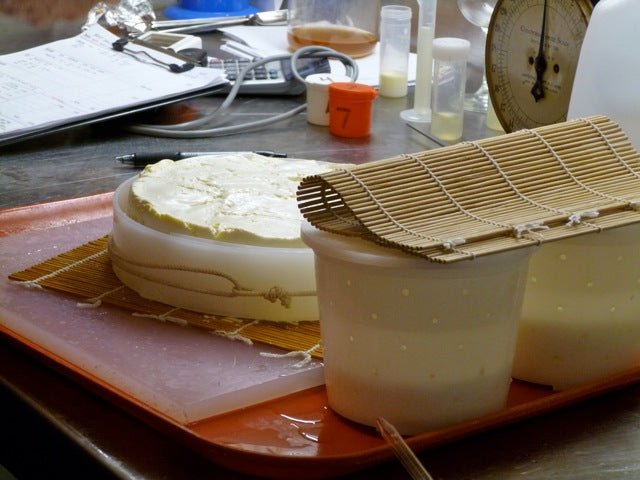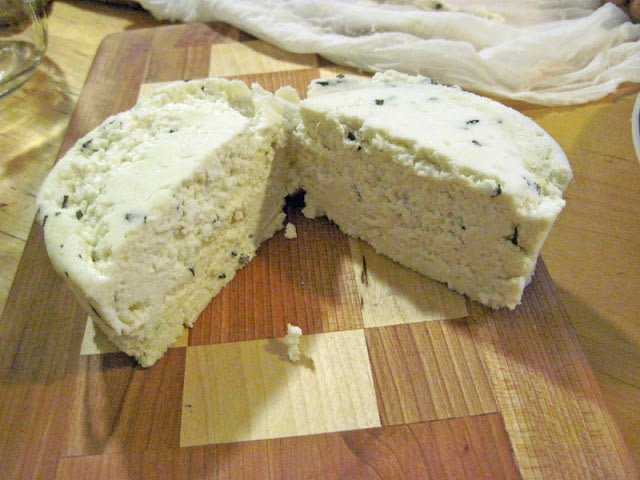Simona Carini attended Jim’s advanced class in French Cheese Making this past May.
You may remember Simona from her post about English Style Coulommiers which we published in June. Her website, briciole, is a great place to learn Italian while you make food and listen to music. (In case you’re wondering, briciole usually means fragments like breadcrumbs, and other crumbled items but it is also used to refer to intangible things, like happiness.)
Simona has been making cheese for years, using our book Home Cheese Making. She sent us her picture at right with this description of the cheeses shown,
Recently, Simona journeyed from her home in California to one of Jim’s workshops in Shelburne Falls, MA and wrote a wonderful article about the experience:
un weekend a Shelburne Falls
http://briciole.typepad.com/blog/2011/06/un-weekend-a-shelburne-falls.html
a weekend in Shelburne Falls (MA)
As I mentioned in a recent post, we recently spent a weekend in Shelburne Falls, MA. Before I tell you a bit more about our visit, let me clarify a language detail: The Italian word for weekend is fine settimana. (settimana means week; fine in this context means end). However, the English word weekend has become part of the spoken language, so I have ben using it in the title of posts where I talk about weekend trips (for example, here and here).
We went to Shelburne Falls, so I could attend a cheesemaking 201 workshop (more on this below) and my husband could visit a family member, who lives in the area. In terms of lodging options, we found a really nice apartment, which made our stay quite comfortable. As mentioned in this post, a well-furnished kitchen allowed me to cook while there, something that contributed to make our stay even more pleasant.
The two-day workshop kept me busy till fairly late in the afternoon (pomeriggio), so our exploration did not go further than the village itself on both sides of the Bridge of Flowers (ponte dei fiori), which spans the Deerfield River (The vehicle bridge parallel to it is called Truss Bridge).
As you can expect, there are falls (cascate) in Shelburne Falls, and here they are:
In the foreground of the photo, you can see another local attraction: the glacial potholes.
The Native Americans called this area Salmon Falls, and the fishing here was so fine that warring tribes made an agreement that they wouldn’t fight each other within one day’s walk of the falls… Ever since the end of the last Ice Age, stones trapped swirling in the riverbed have been grinding into the rock bed below, creating more than 50 near-perfect circles. (source: Lonely Planet)
Past the falls, there are two other points of interest, the Trolley Museum (which we did not get to visit, because it closed too early for my schedule) and the Lamson & Goodnow factory of cutlery. The latter’s building (from 1850) totally fascinated me and I went back to it every day, to see it in the evening light. The covered passage, in particular, intrigued me:
I loved the bright red paint on the building below, which was visible from above the falls and I have decided I will have our house painted that color, when we decide it is time to redo the outside. Don’t you think it’s fabulous?
The two-day cheese-making workshop was simply great. Jim Wallace, well known to anybody who has browsed the New England Cheesemaking Supply Company website and/or receives their monthly newsletter, generously shared his knowledge about not only the three cheeses that were part of the program (Reblochon, Brie and Tomme de Savoie), but also about a wide range of topics related to making cheese at home.
On both days, we had a cheese-tasting session that included some cheeses made by Jim and some made by workshop’s participants. During the first session, I fell in love with a cheese called Tomme au Marc, which I hope to be able to make in the fall, the limiting factor being the availability of crushed grapes in which to age the cheese. Jim’s recipes for various cheeses, including the ones mentioned above, are available on this page.
The seven participants, myself included, had a lot of questions for Jim and he addressed all of them, while we followed his recipes for making the three cheeses on the agenda. One interesting thing that happened when we made both Reblochon and Brie is that, due to the richness of the cow milk (latte di mucca) used, we ended up with more curds than would fit in the prepared molds. In both cases Jim made extra cheese using non-standard molds, as you can see in the photo below, where one of the Reblochon cheeses is taller and narrower than the others.
The four photos on the slideshow below all pertain to the making of Reblochon. The last one shows the cheeses the day after they were made.
We were free to take photos during the workshop, but I was usually too busy listening and taking notes, so I have only a small number of images. Here is a parting shot: I like this photo, because it shows a table with various things we used and the beautiful brie in its second mold (again this is how the cheese looked like the day after it was made), plus the two small ones Jim made with the extra curds.
Besides the newsletter, the New England Cheesemaking Supply Company has a blog containing a wealth of information on making cheese at home. For example, a recent post contains a list of cheese-making classes and also advice on how to choose a class that fits your needs. The third photo from the top shows Jim with a group of students: I was one of them not too long ago. My experience making English-style Coulommiers is featured in a recently published post: what an honor!
Being in Shelburne Falls reminded me of how pretty New England is. We visited the area some years ago in the fall, during foliage season, and I have fond memories of that trip. This time of the year, everything is green and blooming, from the Bridge of Flowers to the gardens in front of houses.


























































































































































